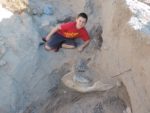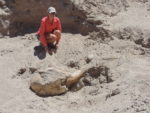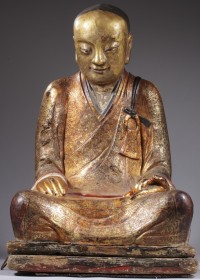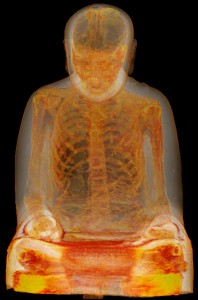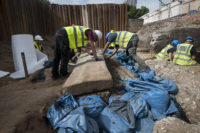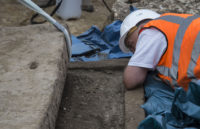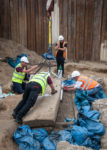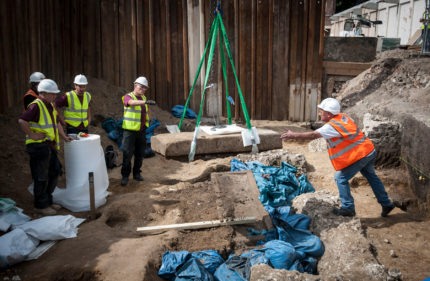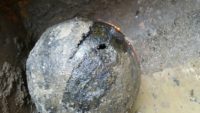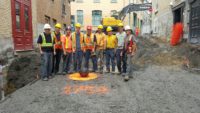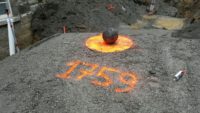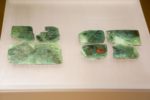 The first complete Roman fleet diploma ever found in Britain has gone on display at Durham University’s Museum of Archaeology. The inscribed copper alloy plaques record the rights granted an honorably discharged sailor after many years of loyal service. The recipient of the fleet diploma, one Tigernos, is Britain’s first named sailor.
The first complete Roman fleet diploma ever found in Britain has gone on display at Durham University’s Museum of Archaeology. The inscribed copper alloy plaques record the rights granted an honorably discharged sailor after many years of loyal service. The recipient of the fleet diploma, one Tigernos, is Britain’s first named sailor.
Roman Military Diplomas were the physical proof of rights granted to non-citizen soldiers to mark their honourable discharge on retirement after 26 years of service. This diploma was issued by the emperor Antoninus Pius (AD 138-191) to Tigernos, a native of Lanchester, Co. Durham, in around AD 150. The diploma granted him and his descendants Roman citizenship and the legal right of marriage. To earn the diploma he had served in the Classis Germanica -the Roman fleet in Germany, most likely for 26 years, before being honourably discharged on his retirement.
 It was discovered in February of last year by metal detectorist Mark Houston near Longovicium, the Roman fort in Lanchester, County Durham. Houston found the plates about eight inches below the surface in a spot where his detector had signalled loud and clear. He saw the tell-tale green of copper and cleaned around it, revealing a small stack of copper plates. He had no idea what it was at first, or even that it was ancient. He thought it might be the remains of a motorcycle battery or some other old piece of machinery.
It was discovered in February of last year by metal detectorist Mark Houston near Longovicium, the Roman fort in Lanchester, County Durham. Houston found the plates about eight inches below the surface in a spot where his detector had signalled loud and clear. He saw the tell-tale green of copper and cleaned around it, revealing a small stack of copper plates. He had no idea what it was at first, or even that it was ancient. He thought it might be the remains of a motorcycle battery or some other old piece of machinery.
 So Houston dug them up, took them home and cleaned them. It was only when he put them on the window sill where the sunlight streamed over them that he saw there were letters engraved on the copper sheets. He took a closer look through a magnifying glass and realized it was Latin. Understanding that what he thought were old motorcycle parts could be ancient artifacts, Mark Houston contacted
So Houston dug them up, took them home and cleaned them. It was only when he put them on the window sill where the sunlight streamed over them that he saw there were letters engraved on the copper sheets. He took a closer look through a magnifying glass and realized it was Latin. Understanding that what he thought were old motorcycle parts could be ancient artifacts, Mark Houston contacted  the Portable Antiquities Scheme (PAS) and reported his discovery. PAS experts and Dr. Roger Tomlin from Oxford University have been studying and conserving it ever since.
the Portable Antiquities Scheme (PAS) and reported his discovery. PAS experts and Dr. Roger Tomlin from Oxford University have been studying and conserving it ever since.
The thin sheets of copper alloy were originally two rectangular plates stitched together by metal wires threaded through  holes in the plates. Over time, the two rectangles corroded and broke into eight fragments, so some areas of the inscription are damaged, missing or illegible. Researchers are still working out as much of the inscription as they can, but what they’ve already been about to transcribe and translate paints a detailed picture, listing names of military cohorts, commanders, governors and consuls as well as the recipient and his father.
holes in the plates. Over time, the two rectangles corroded and broke into eight fragments, so some areas of the inscription are damaged, missing or illegible. Researchers are still working out as much of the inscription as they can, but what they’ve already been about to transcribe and translate paints a detailed picture, listing names of military cohorts, commanders, governors and consuls as well as the recipient and his father.
The Emperor Caesar Titus Aelius Hadrianus Antoninus Augustus Pius, son of the deified Hadrianus, grandson of the deified Trajanus conqueror of Parthia, great-grandson of the deified Nerva, pontifex maximus, in his 13th year of tribunician power [150 A.D.], twice acclaimed Imperator, four times consul, father of his country, has granted to the cavalrymen and infantrymen of the Germany Army Dutiful and Loyal (PF) who have served in the 4 alae and 14 cohorts which are called Noricorum, Sulpicia CR, Africorum Veterana, I Thracum, I Flavia Hispanorum, I
Latobicorum et Varcianorum, I Pannoniorum et Dalmatarum, II Civium Romanorum (CR), I Raetorum, VI Brittonum PF, II Asturum PF, I Classica PF, III and VI Breucorum, I Lucensium PF, II Varcianorum, VI Raetorum, IV Thracum, and are in Lower Germany under Salvius Iulianus, who have served 25 years, likewise soldiers of the Fleet 26 years, and have been honourably discharged, whose names are written below, Roman citizenship to those who do not have it, and the right of legal marriage with the wives they had when citizenship was given to them, or with those they later marry, but only one each.
The 13th day before the Kalends of December [November 19] in the consulship of Gaius Curtius Justus and Gaius Julius Julianus.
To Velvotigernus son of Magiotigernus, a Briton, ex-private soldier of the German Fleet Dutiful and Loyal which Marcus Ulpius Ulpianus commands.
 I love the “only one wife each” stipulation.
I love the “only one wife each” stipulation.
There are only 800 Roman fleet diplomas known to exist, and most of them are incomplete because the children of the recipient would break off pieces to use as proof of their citizenship. Because this is the only complete example found in Britain, it is of enormous archaeological and historical import. Even so, the plates fell through a loophole in the UK’s Treasure Act: the only complete Roman fleet diploma ever discovered in Britain is not made of precious metal, therefore it’s not official treasure and the finder can dispose of it as he wishes.  This is the same loophole that allowed the spectacular Crosby-Garret helmet to be sold to the highest bidder at auction instead of in a museum. Thankfully in this case the finder agreed to sell the diploma plates to the Museum of Archaeology at Durham University and split the proceeds with the landowner.
This is the same loophole that allowed the spectacular Crosby-Garret helmet to be sold to the highest bidder at auction instead of in a museum. Thankfully in this case the finder agreed to sell the diploma plates to the Museum of Archaeology at Durham University and split the proceeds with the landowner.
As of July 20th, Velvotigernus’ fleet diploma is on permanent display the museum’s Palace Green Library.
